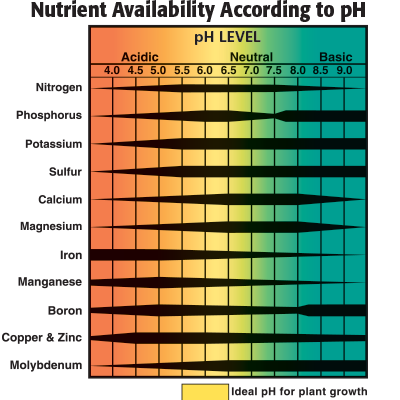pH and Nutrition in Hydroponics
Water also is known as H20 because it has two hydrogen atoms and one oxygen atom for each water molecule. From this base molecule, it can accept an additional hydrogen ion to become H3O, and become acidic. It can also lose a hydrogen ion to become HO, and become basic (alkaline). The pH scale is a measure of whether water has additional hydrogen ions (lower on the scale, acidic), or is missing hydrogen ions (higher on the scale, basic).
Pure water has a pH of 7, and is the center point of the pH scale. It is neither an acid or a base.
Substances that have extra hydrogen ions to donate to the water, are known as acids. If you add an acid to water, it gives the water extra hydrogen ions, and the water becomes more acidic. The more extra hydrogen ions there are, the stronger the acid, and the lower the pH value. This is why if the nutrient solution tests too high of a pH, you can add General Hydroponics? pH Down to lower pH. The acid in pH Down donates hydrogen ions.
Substances that will soak up and capture hydrogen ions from water are known as bases or alkalines. If you add a base to water, it will take away hydrogen ions from the water, and the water will become more basic. If the pH reading of a nutrient solution is too low, adding a base such as General Hydroponics? pH Up to capture hydrogen ions and raise your pH.
Understanding pH Readings
Acids have a low pH, and bases have a high pH, pure water sits in the middle at 7. The lowest number on the pH scale is 0, which is a very strong acid, and the highest is 14, which is a very strong base.
The pH scale is logarithmic, not linear. Each full number difference is a factor of ten in difference. For example, pure water has a pH of 7, a pH of 6 is a 10 times stronger acid, and a pH of 5 is 100 times stronger.
To check the pH of your nutrient solution, either use a meter, or a General Hydroponics pH Test Kit. To use the test kit, fill the test vial halfway with the solution to be tested, and add 3-5 drops of the pH test indicator fluid. Cap the vial, and tap the side while holding lightly to mix. Compare the color of the liquid to the colors on the label. If the resulting fluid is yellow, the pH is around 6.0 and acceptable to use. Orange or red indicate low pH, add pH UP in increments of 1-2 ml per gallon, giving each treatment time to disperse before retesting. Green or blue indicates high pH, add pH Down as above to lower pH.
Since the test fluid is only used at a few drops at a time, the bottle that comes with the test kit lasts for many tests, and does not require batteries or calibration.
Source:General Hydroponics
- Chemical Composition Of Tea
Tea is a very popular drink in world. Tea cultivated mainly in hilly where soil is acidic, high humidity ( heavy rainfall ) is present, good drainage facility for water passing away, partially shade is present. main components of tea are given below:...
- What Is Hydroponics?
Hydroponics is a technology for growing plants in nutrient solutions (water containing fertilizers) with or without the use of an artificial medium (sand, gravel, vermiculite, rockwool, perlite, peatmoss. coir, or sawdust) to provide mechanical support....
- Effects Of Vinegar And Baking Soda On Soil Ph
Saturday, July 20, 2013 By Michelle Brunet Most plants prefer a soil pH between 6 and 7, states Cornell University's Garden Mosaics. A pH over 7 is alkaline and less than 7 is acidic. Some plants prefer an acidic soil less than 6, such as lilies,...
- Hydroponics Technology
Hydroponics is a technology for growing plants in nutrient solutions (water containing fertilizers) with or without the use of an artificial medium (sand, gravel, vermiculite, rockwool, perlite, peatmoss. coir, or sawdust) to provide mechanical support.Liquid...
- What Is Hydroponics?
Hydroponics is a technology for growing plants in nutrient solutions (water containing fertilizers) with or without the use of an artificial medium (sand, gravel, vermiculite, rockwool, perlite, peatmoss. coir, or sawdust) to provide mechanical support....
